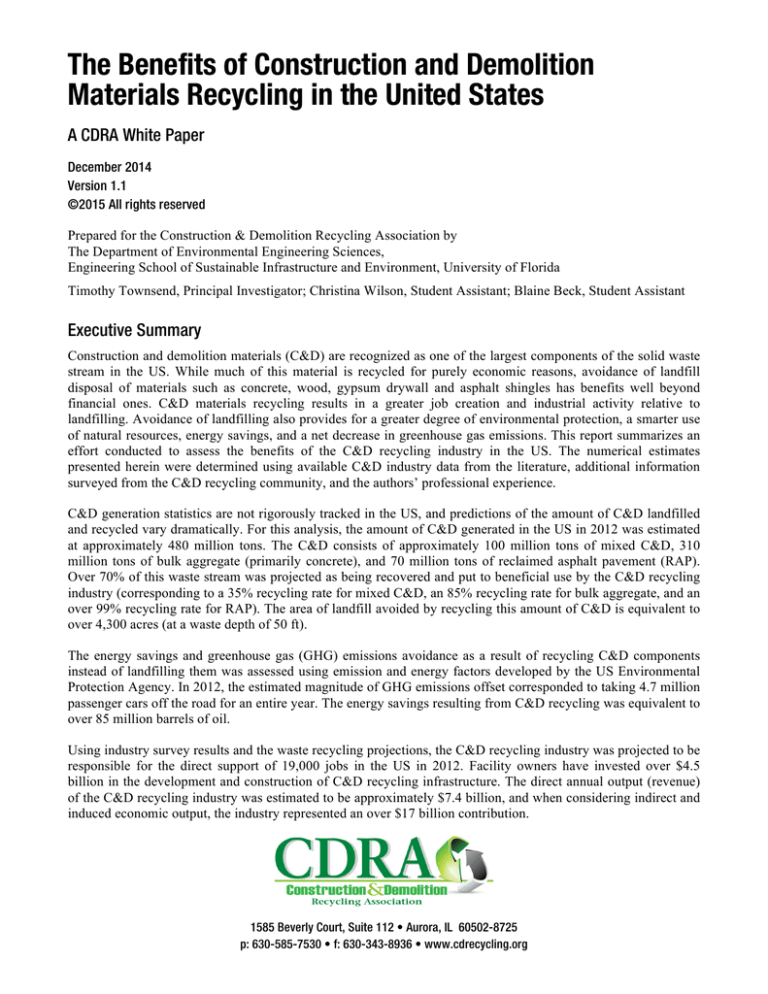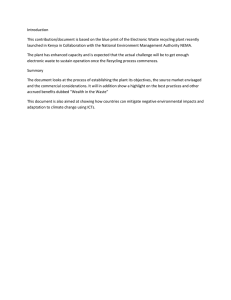
The Benefits of Construction and Demolition
Materials Recycling in the United States
A CDRA White Paper
December 2014
Version 1.1
©2015 All rights reserved
Prepared for the Construction & Demolition Recycling Association by
The Department of Environmental Engineering Sciences,
Engineering School of Sustainable Infrastructure and Environment, University of Florida
Timothy Townsend, Principal Investigator; Christina Wilson, Student Assistant; Blaine Beck, Student Assistant
Executive Summary
Construction and demolition materials (C&D) are recognized as one of the largest components of the solid waste
stream in the US. While much of this material is recycled for purely economic reasons, avoidance of landfill
disposal of materials such as concrete, wood, gypsum drywall and asphalt shingles has benefits well beyond
financial ones. C&D materials recycling results in a greater job creation and industrial activity relative to
landfilling. Avoidance of landfilling also provides for a greater degree of environmental protection, a smarter use
of natural resources, energy savings, and a net decrease in greenhouse gas emissions. This report summarizes an
effort conducted to assess the benefits of the C&D recycling industry in the US. The numerical estimates
presented herein were determined using available C&D industry data from the literature, additional information
surveyed from the C&D recycling community, and the authors’ professional experience.
C&D generation statistics are not rigorously tracked in the US, and predictions of the amount of C&D landfilled
and recycled vary dramatically. For this analysis, the amount of C&D generated in the US in 2012 was estimated
at approximately 480 million tons. The C&D consists of approximately 100 million tons of mixed C&D, 310
million tons of bulk aggregate (primarily concrete), and 70 million tons of reclaimed asphalt pavement (RAP).
Over 70% of this waste stream was projected as being recovered and put to beneficial use by the C&D recycling
industry (corresponding to a 35% recycling rate for mixed C&D, an 85% recycling rate for bulk aggregate, and an
over 99% recycling rate for RAP). The area of landfill avoided by recycling this amount of C&D is equivalent to
over 4,300 acres (at a waste depth of 50 ft).
The energy savings and greenhouse gas (GHG) emissions avoidance as a result of recycling C&D components
instead of landfilling them was assessed using emission and energy factors developed by the US Environmental
Protection Agency. In 2012, the estimated magnitude of GHG emissions offset corresponded to taking 4.7 million
passenger cars off the road for an entire year. The energy savings resulting from C&D recycling was equivalent to
over 85 million barrels of oil.
Using industry survey results and the waste recycling projections, the C&D recycling industry was projected to be
responsible for the direct support of 19,000 jobs in the US in 2012. Facility owners have invested over $4.5
billion in the development and construction of C&D recycling infrastructure. The direct annual output (revenue)
of the C&D recycling industry was estimated to be approximately $7.4 billion, and when considering indirect and
induced economic output, the industry represented an over $17 billion contribution.
1585 Beverly Court, Suite 112 • Aurora, IL 60502-8725
p: 630-585-7530 • f: 630-343-8936 • www.cdrecycling.org




